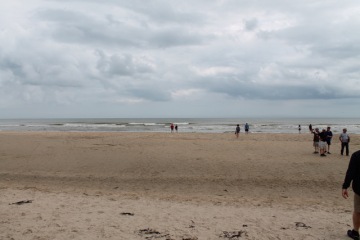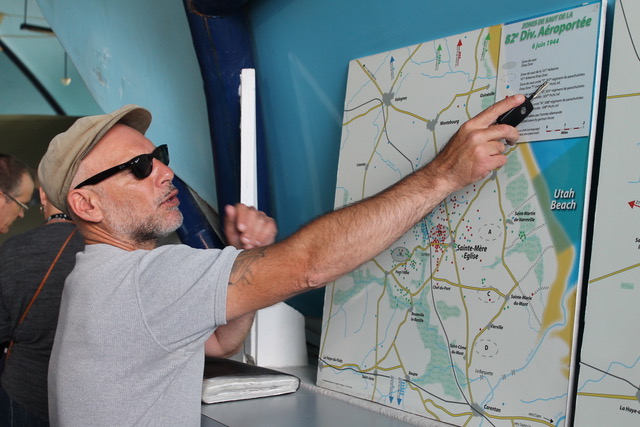Leslie and I celebrated Independence Day in Normandy, wearing red, white and blue. We visited Sainte-Mère-Église, where paratroopers from the 82nd Airborne Division spearheaded the D-Day invasion on the night of June 5, 1944. We walked on Utah and Omaha beaches where the American army poured out of little flat-bottomed boats and helped take back a continent. We stood on sacred ground in the American cemetery in Colleville, surrounded by the graves of those who died in that operation, some of whom never made it off the beaches.

This was kind of a “bucket list” trip for me. I had brief affiliations with the 82nd and the 1st Infantry Division during my time in uniform, and I thought of this as similar to a pilgrimage. Our excellent guide, Francois, told us the 1962 film “The Longest Day” was filmed mostly in places where the historic events took place, such as in Sainte-Mère-Église. If you’ve seen the movie, you may remember a solider, Pvt. John Steele, whose parachute got caught on the steeple of the town’s church. He was stranded there with German soldiers shooting at him. There’s a dummy hanging there now — in the wrong place. Francois explained that the movie showed Steele, played by Red Buttons, dangling from a steeple overlooking the town square. But in reality, he was on the other side of the building. A minor distinction — except to John Steele.

We went to Utah Beach, where Francois apologized that we arrived at high tide. The invasion happened at low tide, and he wanted us to see how far the soldiers had to move across the beach. We had to visualize how they left flat-bottomed Higgins boats — named for their American inventor — and made their way inland. He said this landing had success in part because aerial bombardment was more accurate than in other sectors, and because most of the Sherman tanks made it onto the beach to support ground troops.

Pointe du Hoc is a spot between Utah and Omaha beaches where U.S. Army Rangers, led by Lt. Col. James Rudder of Texas, had to scale 100-foot cliffs to destroy artillery emplacements that were part of Germany’s impressive Atlantic Wall defense. As Francois explained, the Germans had removed all the 155mm howitzers (big cannons) to protect them from Allied bombardment. But two Rangers found the weapons hidden in a wooded area and the mission became a success. We saw the craters from Allied bombs, and we climbed over and through what’s left of the concrete German bunkers.

The views from this place are incredible. We could see other cliffs in the distance and got a feel for what these young men had to deal with. Casualties were heavy. Of the 225 Rangers who hit the beach that morning, 80 were killed in the assault and only 90 were still able to continue at the end of the day.

The American army met the stiffest resistance at Omaha Beach, where aerial bombardment was less effective and most of the tanks didn’t make it to shore. Francois described how bomber pilots were instructed to fly above the clouds to avoid antiaircraft fire. Only a small percentage of bombs reached their target, and the landing force walked right into a devastating crossfire. Because the assault happened at low tide, some of the landing craft hit sandbars and deposited soldiers too early. Many were forced to traverse a distance of three or four football fields, sometimes wading in neck-deep water wearing full combat gear. More than 1,000 men died on this beach.

We ended the day at the cemetery, which is literally American soil — given to the U.S. in gratitude by the French government. Thanks to Francois’ excellent driving, we arrived just in time to see the 5 p.m. flag-lowering ceremony. Every day, two American flags are lowered and “taps” is played as the second one comes down. I’ll admit I got a little choked up. After the ceremony, I was able to stroll the main walkway and look down the rows of white crosses, with a few Stars of David in the mix too. They’ve been gone for 74 years, but as a U.S. Army veteran I still see them as my brothers. They make me proud to have worn the uniform.
Next time, Leslie fulfills a childhood dream.
UPDATE: Mexico has been knocked out of World Cup competition, but France won its quarterfinal final match against Uruguay, 2-0, so they’re still in the hunt. We’re pulling for France, but no, the World Cup winner won’t determine where we’ll be living six months from now!


Thanks for sharing. What a great experience to be there on the 4th. Jack and I will go there too one day, hopefully not too long from now. Enjoy Ireland.
LikeLike
Thanks, Joyce. You really should visit Normandy. There are a number of tour companies. We can talk when we see you, which will be soon!
LikeLike